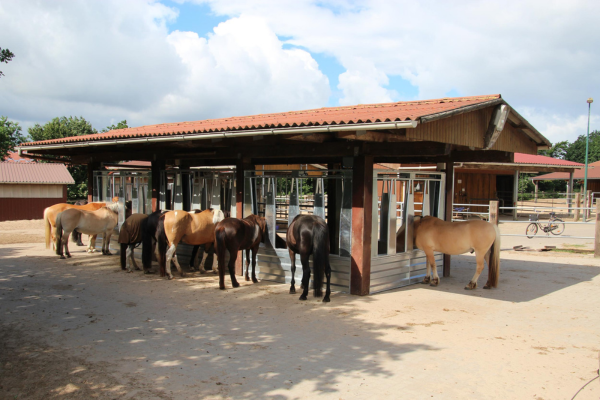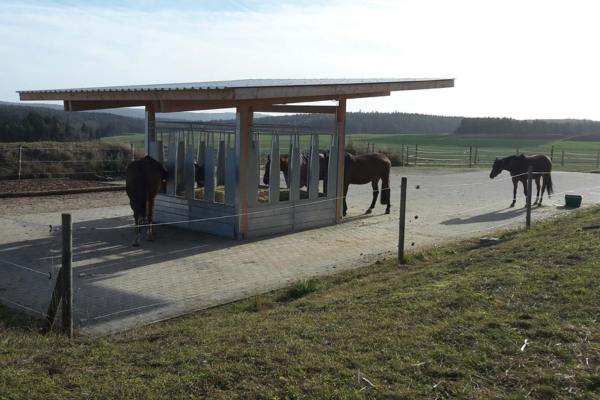Posted: 19th March 2024 | Back to news feed


Horses naturally engage in slow-paced eating for approximately 12-16 hours per day and cover considerable distances. Their gastrointestinal tract has adapted to a continuous intake of food and satisfaction is not reached by a filled stomach but rather by the number of chewing strokes and resulting fatigue of the masticatory muscles through biting and chewing (Meyer and Coenen, 2014, Zeitler-Feicht, 2008).
Research also notes that horses avoid fasting for longer than 3–4 hours and perform about ten feeding periods distributed over 24hours (Harris, 2005, Ralston, 1984, Zeitler-Feicht, 2008). This presents a responsibility on our part as horse owners to find a suitable method of accurately managing our horse’s routine in a species appropriate way.
As science expands our knowledge many horse owners are beginning to acknowledge that there is a discrepancy between the routine of stabled horses and that of natural feeding behaviour. The feeding management of stabled horses is being attributed to disturbances in the digestive system such as gastric ulcers (Flores et al., 2011, Murray and Eichorn, 1996), colic (Cohen et al., 1999, Hudson et al., 2001) and also stereotypies like wood chewing, crib biting.
Providing extended feeding time without compromising nutrition.
Horses provided with a continuous forage (hay/straw) supply showed less agonistic and more positive social behaviour than horses with limited forage supply (Benhajali et al., 2009, Jørgensen et al., 2011).
To prevent obesity, feeding times can be extended using traditional methods like hay nets, or controlled by the use of transponders or time-regulated hay racks. Even with controlled feeding times, it's crucial to ensure that horses always have access to something to nibble on. Insufficient roughage intake is recognized as a primary contributor to physiological and behavioral disorders, a conclusion supported by various scientific studies.
Even with the intervention of primitive methods of group housing, agonistic behaviour can arise through competition of resources and feeding space available (Hartmann et al., 2012).
Are hay nets a reliable method of extending feeding time?
To extend the feeding time and reduce the amount of feed, hay nets with different mesh sizes are often used. According to the studies of the College Caball in Germany, the feeding time is extended by an average of 30% with a mesh size of 4-6cm and only by an average of 50% from a mesh size of less than 3cm. A mesh size of more than 6cm has hardly any effect.
However, hay net feeding has a different effect on the feeding speed of each horse. Some horses were not impressed by the hay nets at all and ate the same amount as with loose hay. Others, on the other hand, refused to eat completely and became aggressive. It is also noted that horses can get used to being fed hay nets and there is no longer any noticeable difference to loose hay feeding.
Whilst many of us do it, there are some criticisms of feeding by hay nets. Among other things, it has been observed that horses can become stressed with a small mesh size, especially when the hay net is hung up. In addition, both the head posture and the lack of natural position of the front legs have been questioned. The teeth can also be affected. After the studies, The College Caball concluded that feeding via close-meshed hay nets does not represent species-appropriate feed intake.

What is a species appropriate solution to feeding horses in groups or stables?
At Jelka, we specialize in group housing infrastructure and the feeding management of horses is an integral part of this. Our solution (HIT Active Stable) is a purposefully designed space with specialized feeding automation systems being timed or transponder controlled. In this way we can correspond feeding patterns like natural conditions for every individual horse no matter what the size, age, or breed.
Feeding area design and management is key to reducing agonistic behavior in group housed horses and group housing is the only method of providing the balance between longer feeding times and continuous locomotion. Both elements are necessary for not only weight and nutrition management, but also improve physiological and psychological well being and ultimately give our horses a better life.
For more information visit www.jelka.co.uk
The Equestrian Index newsfeed is compiled from articles submitted by advertising members and expresses the opinions of those members. Watsons Directories Ltd shall not be held liable for any inaccuracies or mis-statements therein.